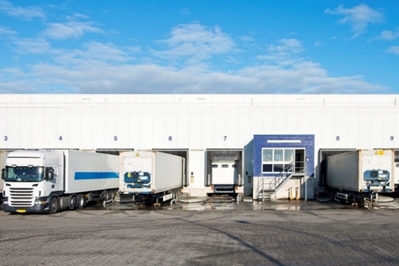| This guidance sheet forms part of a series of guidance sheets on preventing and managing offensive odours, and should be read in conjunction with EPA Victoria’s Odour Guidance for Industry webpage. |
 Figure 1 – an example of a well-structured receival bay demonstrating proper site management.
Figure 1 – an example of a well-structured receival bay demonstrating proper site management.
Description
How you plan and manage your site can greatly reduce odour, through preventing problem odour before it occurs, and containing odour if it is generated.
Site planning refers to determining where buildings and processes will occur on your site. For instance, good site planning could be ensuring receival bay doors are facing away from sensitive receptors, or establishing a close proximity between odour producing areas, odour capture, and odour treatment systems.
Management refers to the ongoing oversight of buildings and processes occurring on your site. For instance, good site management could include keeping a daily record of the condition of odour prevention methods and equipment, or monitoring performance and maintenance of key equipment at your site.
Type of control
Physical.
When you would use this?
Correct site planning and management is best undertaken when establishing a new site. However, planning and managing your site is an ongoing responsibility.
Suitable for: as this control involves the planning and management of sites it can be implemented to control almost any odour or potential odour.
Industries that would use this: all industries could benefit from this control. In particular, sites that receive, manage, or produce highly odorous materials have the most to gain from this control. It is also highly recommended for businesses conducting potentially odorous activities outside.
Details and considerations
While site planning and management may be easily implemented, the following should be taken into consideration:
- Planning your site provides you and your employees with a framework in which to work, but it does not provide the odour control in and of itself, only following your site plan can achieve this.
- Each business and site will have its own set of challenges. Site planning will almost always require the implementation of additional controls.
- If you run a high-risk, or large-scale business it may be necessary to engage a consultant to support you in developing a site plan, or identifying management strategies. See EPA’s guide to engaging a consultant.
Factors to consider when developing a site plan or management strategy:
| Factors |
Examples |
Understanding
your processes |
- Understand the site areas that pose the most risk in generating odour.
- During site planning, or as soon as possible thereafter, ensure you have identified effective odour control solutions. An example of management actions is keeping records around these processes once in operation.
|
Proximity to
neighbours and
sensitive
receptors |
- If your site has neighbouring properties that include private residences, schools, kindergartens, universities, or other areas where people congregate, it is important to manage your processes and operational timing. This includes activities such as receiving materials, undergoing processes, and if possible, locations where receivals are handled.
|
Odorous raw
materials |
- Keep receival bay doors closed when not in use to keep odour-producing materials enclosed.
- Consider using automated door closing systems and rapid fall doors.
- Pull trucks directly up to receival bays to minimise exposure to outside air.
- Consider having a double roller door system such as an airlock.
- Where possible, plan for odour producing processes to occur indoors.
|
Storage of
odourous
materials |
- Always store odorous materials inside where possible.
- If odourous material must be stored outside, ensure you use an appropriate odour cover.
|
Weather
conditions |
- Understand typical local wind direction around your site – this can inform the best way to set up your site to help minimise odours impacting neighbours.
- Understand the conditions of your site (is the site regularly wet, humid, dry, or hot?) as this may influence odour production.
- Restrict outdoor odour producing processes on days which are especially hot (over 35 degrees Celsius) or windy to minimise risk of odour during these conditions.
|
| Cleaning |
- Any spills, residual odorous material, or animal holding areas should be cleaned as soon as possible.
- Consider providing a truck washing facility at your site so trucks are free of odorous residues when leaving your site.
|
Planning
requirements |
- You should ensure, when planning your site, that it is in accordance with all state and local laws (such as local planning laws and building regulations). Further information may be obtained from Local council or Victorian Building Authority (VBA).
|
Further information
Recommended Separation Distances for Industrial Residual Air Emissions – Guideline (EPA publication 1518) provides guidance on buffer requirements for minimum distances between odour producing sources and your site perimeter.